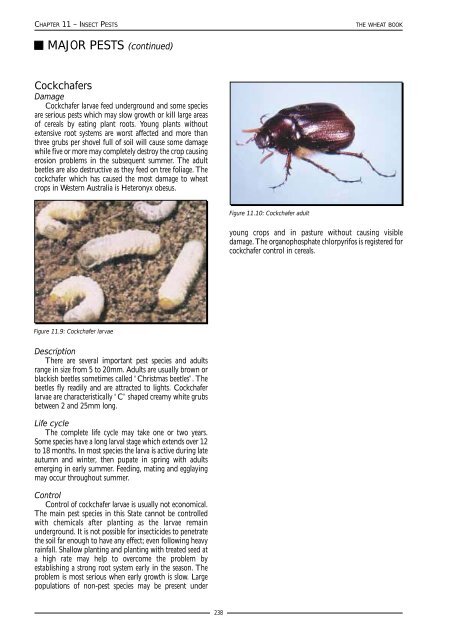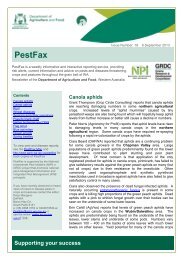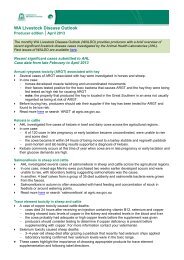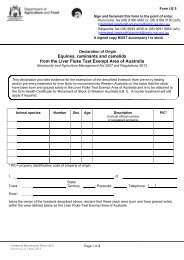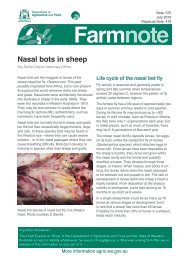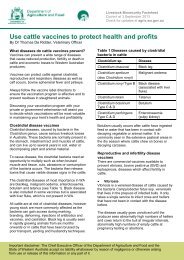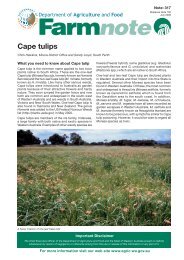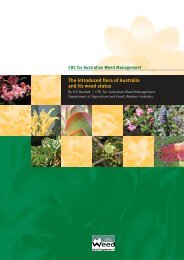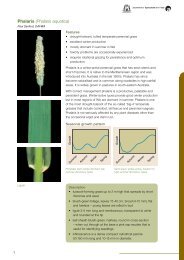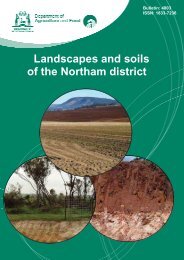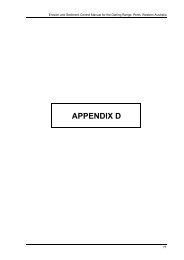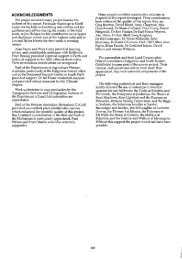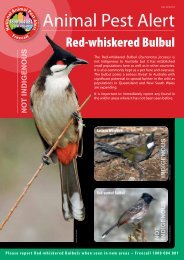The wheat book : principles and practice - Department of Agriculture ...
The wheat book : principles and practice - Department of Agriculture ...
The wheat book : principles and practice - Department of Agriculture ...
Create successful ePaper yourself
Turn your PDF publications into a flip-book with our unique Google optimized e-Paper software.
CHAPTER 11 – INSECT PESTS THE WHEAT BOOK<br />
MAJOR PESTS (continued)<br />
Cockchafers<br />
Damage<br />
Cockchafer larvae feed underground <strong>and</strong> some species<br />
are serious pests which may slow growth or kill large areas<br />
<strong>of</strong> cereals by eating plant roots. Young plants without<br />
extensive root systems are worst affected <strong>and</strong> more than<br />
three grubs per shovel full <strong>of</strong> soil will cause some damage<br />
while five or more may completely destroy the crop causing<br />
erosion problems in the subsequent summer. <strong>The</strong> adult<br />
beetles are also destructive as they feed on tree foliage. <strong>The</strong><br />
cockchafer which has caused the most damage to <strong>wheat</strong><br />
crops in Western Australia is Heteronyx obesus.<br />
Figure 11.9: Cockchafer larvae<br />
Description<br />
<strong>The</strong>re are several important pest species <strong>and</strong> adults<br />
range in size from 5 to 20mm. Adults are usually brown or<br />
blackish beetles sometimes called “ Christmas beetles” . <strong>The</strong><br />
beetles fly readily <strong>and</strong> are attracted to lights. Cockchafer<br />
larvae are characteristically “ C” shaped creamy white grubs<br />
between 2 <strong>and</strong> 25mm long.<br />
Life cycle<br />
<strong>The</strong> complete life cycle may take one or two years.<br />
Some species have a long larval stage which extends over 12<br />
to 18 months. In most species the larva is active during late<br />
autumn <strong>and</strong> winter, then pupate in spring with adults<br />
emerging in early summer. Feeding, mating <strong>and</strong> egglaying<br />
may occur throughout summer.<br />
Control<br />
Control <strong>of</strong> cockchafer larvae is usually not economical.<br />
<strong>The</strong> main pest species in this State cannot be controlled<br />
with chemicals after planting as the larvae remain<br />
underground. It is not possible for insecticides to penetrate<br />
the soil far enough to have any effect; even following heavy<br />
rainfall. Shallow planting <strong>and</strong> planting with treated seed at<br />
a high rate may help to overcome the problem by<br />
establishing a strong root system early in the season. <strong>The</strong><br />
problem is most serious when early growth is slow. Large<br />
populations <strong>of</strong> non-pest species may be present under<br />
238<br />
Figure 11.10: Cockchafer adult<br />
young crops <strong>and</strong> in pasture without causing visible<br />
damage. <strong>The</strong> organophosphate chlorpyrifos is registered for<br />
cockchafer control in cereals.


